2. Upturning the Tea Table Again
Let me explain the reason why production was stopped.“Walk with me!” was originally intended to be completed much earlier, but the software development was delayed, and in Japan the release date overlapped with that of the Nintendo Nintendo DSi. As I’m sure you know, the Nintendo DSi doesn’t have a slot for the GBA Game Pak, so you wouldn’t be able to play this game unless you had an original DS or a DS Lite. I thought that the customers who bought the Nintendo DSi wouldn’t appreciate it very much if we went ahead and released it in this fashion, so we decided to stop production.
It was really tough then. It’s wasn’t easy to come out and say “I’m sorry. Let’s go and remake it in a different way” when everyone had put so much work into making it.
The sight of you looking so crestfallen when you got up to leave my office is burned into my brain. I’m sure it was a big shock for you too when you heard the news, Akita-san.
Of course when I heard the news it was a shock. But since it wasn’t going to be in cartridge format it meant that we would be able to make it more compact, and I decided to reimagine it afresh.
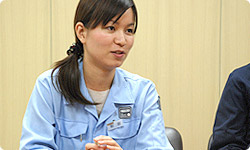
You didn’t need to make it the right size to fit the cartridge slot anymore.
But it meant a new problem came up. How could we transmit the data from the Activity Meter to the DS Card?
When it was in the cartridge format you could transmit the data just by inserting it into the DS.
So that’s why working out how to connect it became our main challenge. There were lots of ways to make the connection, but we talked with the staff from the circuit group and we decided that using an infrared connection would be best. We didn’t need to transfer much data and it didn’t cost much to make. However...
However?
Yet another new problem appeared. DS Game Cards are really small and thin. Just where could we put an IR communications port on a card like that?
I see. The designers never imagined anyone putting an IR port on the Game Card when it was first being designed.
That’s why it was necessary to modify the Game Card. It didn’t look all that great, but we thought about having the IR port stick out the top of the Game Card.
But when we did that, if you just pushed it a little, the DS Card would snap out of the DS console.
With it sticking out the top of the Game Card it made it easier to catch.
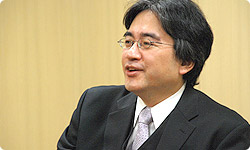
We thought about using a lock function to stop the card snapping out, but when we added that it just made it even more cumbersome.
It would be hard for it to clear the drop test, one of Nintendo’s traditions, with a bit sticking out like that too.
Having it that big was a problem for us, and while we were trying all kinds of things to solve it, a staff member from the circuit group came running up and handed us a small component. When we used this IR port and doubled over the circuit board for the Game Card, we were able to get it to fit inside perfectly.
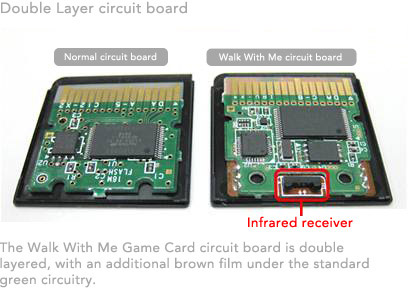
However, this kind of circuit board structure wasn’t something that we’d done at Nintendo before and some people were worried about whether we would be able to mass produce it. But thanks to the work of the staff at the Uji plant, we began to see some promise on the mass production front.
So you just about managed to solve the problem with the DS Game Card, but what about the Activity Meter?
At that point the insides of the circuitry were just about finalised and the size had also been pretty much determined. But, and this was a problem back from when we had been making it in a cartridge format, this time we really wanted to increase the water resistance.
You could take advantage of the opportunity that starting over again gave you.
That’s right. So what we ended making was this. This was made before the designers had worked on it, so the design isn’t all that great.
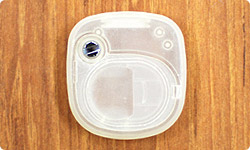
It’s a lot more compact than the cartridge design was.
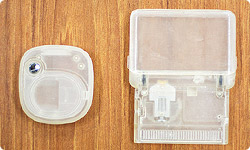
Yes, that’s why I was full of confidence when I went to take it over to Shimomura-san.
And what did he say?
He said, “What’s this? It’s huge!”
(laughs)
I said, “This isn’t any good at all. You have to start over!”
Why did you need to go that far?
The concept we decided on right at the beginning of this project was to make a pedometer without a pace display (LCD screen). We thought it would help people to enjoy the software if they could just walk around normally during the day without paying too much attention to it, and then find out how much they had walked when they turn on the software at the end of the day. And since there wasn’t a LCD it meant we could make it really compact. I wanted to make something that people wouldn’t believe was a pedometer if you showed it to them. But the prototype I was shown then was far bigger than I had been imagining and I thought “how come they can’t they make anything smaller than this?” Although I felt sorry for Akita-san.
It must have been a real shock to have the apple-cart upturned on you a second time, Akita-san?
But my job is to design the case for the circuit board. So I walked over to the circuit group and just repeated Shimomura-san’s words straight to them. “This isn’t any good at all. You have to start over!”
(laughs)
When I told them, “it needs to be smaller!” the staff from the circuit group really worked hard. They started the design again from scratch, even the placement of the screws, and in order to make it just as small as possible, they kept making very fine adjustments, again and again, and in the end what we came up with was this.
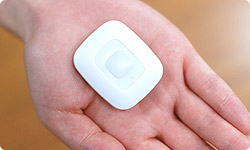
See, you can do it when you try. (laughs)
Now this really is quite small.
While we’ve of course made it smaller, with this round shape, like a piece of soap, it won’t bother you at all if you put it in your pocket. It doesn’t hurt even if it rolls around onto its side.
It seems like you even did tests to see if it would hurt if you stepped on it with bare feet. (laughs) By the way, this compact Activity Meter has a special feature you won’t find in your average pedometer, doesn’t it?
Do you mean the function to record your step data for each minute?
Why did you decide to include a feature like that?
There are a lot of pedometers out there, and you can see the total number of steps you have taken in one day, but there wasn’t anything that would let you look more in more detail with the number of steps for each minute. So we made it so it could record the number of steps you take in each minute and gradually build up that data. We thought if we added that function to the hardware in advance they would be able to do something interesting with it on the software side.
In other words, even though you didn’t know how you were going to use it, you added a function that hadn’t been seen in pedometers before. Was that your idea Shimomura-san?
I think maybe my intuition just happened to be working well. As a hardware technician for Nintendo, I’ve had lots of opportunities to think about what kind of fun things you can do when you add all sorts of features to new hardware. That’s why, as far as cost allows, if I find something that looks like it could do something interesting, as a hardware technician, I just want to add it no matter what. After that it’s just a matter of passing the baton to the software developers, saying, “I’m sure you’ll find a use for this function, so I’ve gone ahead and put it in there”.

There is a small lamp (an indicator) attached to this pedometer and when you reach your target number of steps it changes from red to green. Was that also your intuition?
That’s right. Normally lamps like this change colour to indicate that the battery is running low. But since with this device the software will let you know when the battery is low, we thought up another use for it. I thought that if the colour changes when you reach a target number of steps we could come up with an interesting way of using that later. So even I couldn’t picture the finished product at that stage. I just thought, “Right, my part of the work is done, Morimura-san, the rest is up to you. Make something interesting now!”
You really did unveil those developments with impeccable timing. (laughs) Now then, let’s hear a little about the software.
